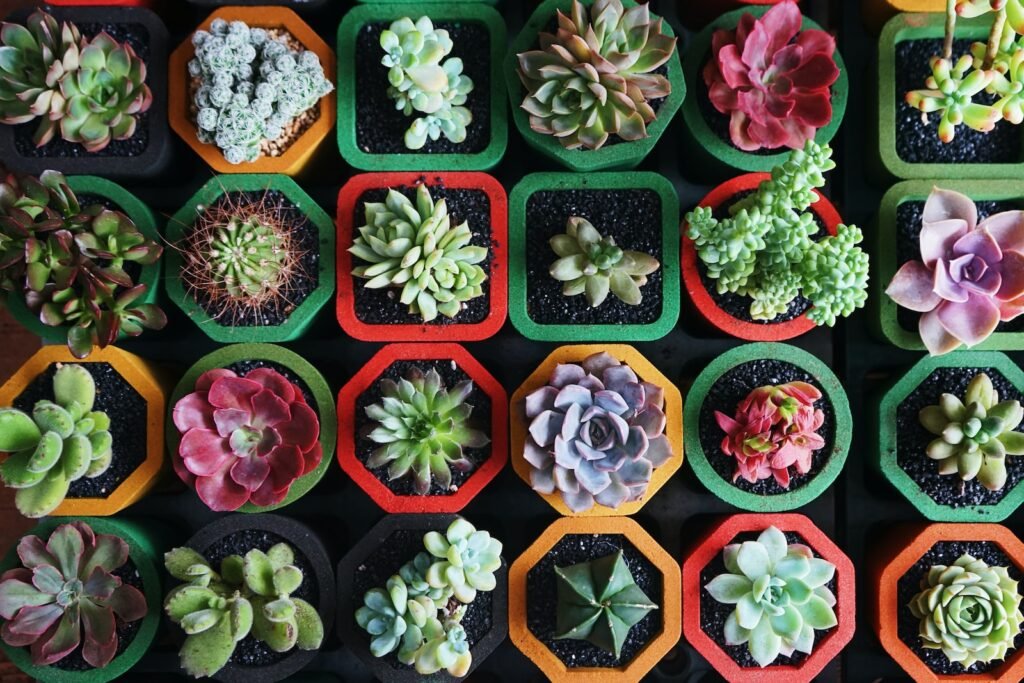
Amazing Varieties of Succulents, their Resilience and Beauty
Succulents are a captivating group of plants that intrigue with their varieties, resilience, and beauty. Varieties of Succulents boast an extraordinary range of forms, colors, and survival strategies that make them a fascinating subject for gardeners, botanists, and plant lovers alike. The term ‘succulent’ comes from the Latin word ‘sucus’, meaning juice or sap; this characteristic is a testament to their ability to store water in their leaves, stems, or roots, enabling them to thrive in arid conditions where other plants would perish.
The diversity of succulents is astounding. They are not confined to one taxonomic group but spread across many families and genera. From the compact rosettes of Echeveria to the towering columns of the Saguaro cactus, from the plump beads of the String of Pearls (Senecio rowleyanus) to the angular geometry of the Aloe polyphylla, each variety presents its own unique aesthetic and ecological niche.
These plants have adapted to some of the harshest environments on Earth, and their adaptations are not just utilitarian but are also of great ornamental value. The leaves of succulents can appear in shades of green, blue, purple, pink, and red, often changing color with the seasons or in response to stressors such as sun exposure and temperature changes. Some, like the Lithops or ‘living stones’, have evolved to mimic their surroundings to avoid being eaten by thirsty animals.
Flowers, too, are a part of the succulent’s charm, emerging sometimes in a sudden burst from an unassuming plant to dazzle with their intricate shapes and vibrant colors. The range of succulent plants is so broad that enthusiasts can spend a lifetime exploring them without exhausting their variety.
Whether one is a seasoned collector or a curious beginner, the world of succulents offers a plant for every taste and a variety for every environment, indoors or out. They ask for little but give much in return, providing a window into the world’s diverse habitats and the ingenuity of nature’s designs.
Varieties of Succultents, Just a Few of Them.
- Aloe Vera: Known for its medicinal gel, this succulent has thick, green leaves with serrated edges and can grow flowers on a spike.
- Echeveria ‘Lola’: Forms a sculpted rosette with a slight pink hue and plump, powdery leaves that can produce coral pink flowers in the spring.
- Crassula ovata (Jade Plant): A popular succulent with thick, woody stems and oval-shaped green leaves that sometimes have a reddish tinge.
- Sempervivum tectorum (Hens and Chicks): Small, rosette-forming plants that grow in clusters with parent “hens” surrounded by “chicks.”
- Opuntia (Prickly Pear Cactus): Known for its distinctive paddle-shaped segments and can produce edible fruits and flowers of various colors.
- Haworthia fasciata (Zebra Plant): Has dark green leaves with white horizontal stripes and a rosette shape, resembling a zebra pattern.
- Sedum morganianum (Burro’s Tail): Features trailing stems with overlapping blue-green leaves that can grow several feet long.
- Kalanchoe blossfeldiana: A flowering succulent with scalloped leaves and clusters of small, brightly colored flowers.
- Senecio rowleyanus (String of Pearls): Displays cascading vines of spherical, pea-like leaves and can bloom small white flowers with a cinnamon scent.
- Agave americana (Century Plant): Known for its large rosettes of tough, pointed leaves and a towering flower spike that blooms once before the plant dies.
- Lithops (Living Stones): Resembles stones or pebbles, this succulent has two fused leaves with a fissure in the center from where flowers emerge.
- Schlumbergera (Christmas Cactus): A popular houseplant with flat, segmented stems and vibrant tubular flowers that bloom around Christmas.
- Euphorbia tirucalli (Pencil Cactus): Characterized by its thin, pencil-like stems and a toxic sap that can irritate the skin.
- Adenium obesum (Desert Rose): Features a thick, swollen stem base called a caudex, with dark green leaves and trumpet-shaped flowers.
- Dudleya (LiveForever): Native to California, these rosettes come in various colors and are known for their longevity.
- Aeonium arboreum (Tree Aeonium): Forms branched stems with large rosettes of succulent leaves, often with a dark, burgundy hue.
- Cotyledon orbiculata (Pig’s Ear): Has thick, rounded gray-green leaves with a red line around the edges and bell-shaped orange flowers.
- Fenestraria rhopalophylla (Baby Toes): This plant has transparent tips on its tubular leaves to allow sunlight to enter, resembling the toes of a baby.
- Gasteria: This genus has tongue-shaped leaves with varied patterns and colors, often flowering with unique, stomach-shaped blooms.
- Mammillaria (Pincushion Cactus): A genus with small, rounded cacti covered in spines, often flowering in a crown around the plant.
- Portulacaria afra (Elephant Bush): Resembling a small jade plant, this succulent has reddish-brown stems with glossy green leaves.
- Graptopetalum paraguayense (Ghost Plant): A rosette-forming plant with pearly blue-green leaves that can turn pink in full sun.
- Pachyphytum oviferum (Moonstones): Known for its chubby, pastel-colored leaves that can range from blue-green to pink.
- Pachypodium lamerei (Madagascar Palm): Despite its name, it’s a succulent with a thick, spiny stem and a top of slender leaves.
- Rhipsalis baccifera (Mistletoe Cactus): A jungle cactus with long, trailing stems and small flowers, it thrives in more humid conditions than most succulents.
- Sansevieria trifasciata (Snake Plant): Has upright, sword-like leaves with distinctive green and yellow variegation, known for its air-purifying qualities.
- Stapelia (Starfish Plant): Best known for its star-shaped flowers and sometimes pungent odor, which attracts flies for pollination.
- Yucca: A genus of perennial shrubs and trees with tough, sword-shaped leaves and a tall stem of white flowers.
- Astrophytum (Star Cactus): This cactus genus is recognized by its star-like shape and speckled appearance, often with woolly areas and yellow flowers.
- Anacampseros rufescens: A small plant with green and purple leaves that form a dense mat, and blooms with pink flowers in the afternoon.
Each of these succulents brings a unique beauty and an interesting story to a garden, making them popular among enthusiasts and collectors.

